There have been many revisions of the USB Arduino board, including the Extreme, NG, and Diecimila.
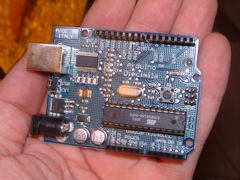
Arduino Diecimila
The most recent USB Arduino is the Diecimila, distinguished
by the text "Arduino Diecimila". The main change from previous boards is that the
Diecimila can be reset from the computer, without the need to physically press the
reset button on the board. The Diecimila uses a low dropout voltage regulator which
lowers the board's power consumption when powered by an external supply (AC/DC adapter
or battery). A resettable polyfuse protects your computer's USB ports from shorts
and surges. It also provides pin headers for the reset line and for 3.3V. There
is a built-in LED on pin 13.
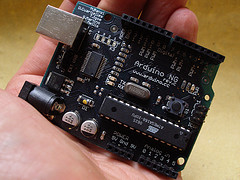
Arduino NG Rev. C
Revision C of the Arduino NG does not have a built-in
LED on pin 13 - instead you'll see two small unused solder pads near the labels
"GND" and "13".
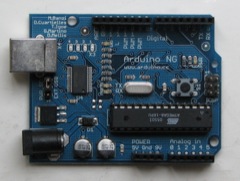
Arduino NG (Nuova Generazione)
The Arduino NG uses the FTDI FT232RL
USB-to-Serial converter, which requires fewer external components that the FT232BM.
It also has a built-in LED on pin 13 (which may interfere with SPI communication).
Later NG's shipped with an ATmega168 instead of an ATmega8, though either chip can
be used with any board.
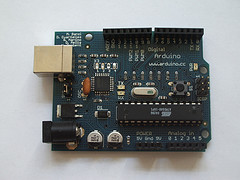
Arduino Extreme v2
Version 2 of the Arduino Extreme uses a gridded
ground plane and includes the new "www.arduino.cc" URL.
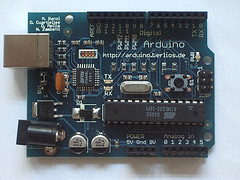
Arduino Extreme
The Arduino Extreme uses many more surface mount
components than previous USB Arduino boards and comes with female pin headers. It
also has RX and TX LEDs that indicate when data is being sent to or from the board.
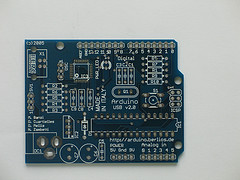
Arduino USB v2.0
The second version of the Arduino USB corrected
the USB connector pinout and updated the URL to "arduino.berlios.de"; it was labelled
"Arduino USB v2.0".
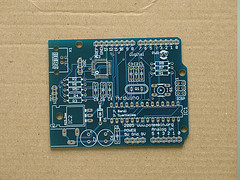
Arduino USB
The Arduino USB was the first board labelled "Arduino".
These were mainly sold unassembled as kits. The first version had an incorrect pinout
for the USB connector and had the URL "www.potemkin.org".
The Arduino BT contains an integrated bluetooth module for wireless communication.
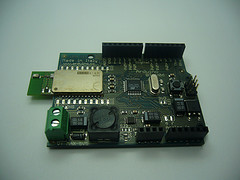
The Mini is a compact Arduino board.
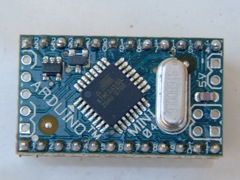
Arduino Mini 04
On this version of the Arduino Mini, two of the pins
changed. The third pin became reset (instead of ground) and fourth pin became ground
(instead of being unconnected). These boards are labelled "Mini 04".
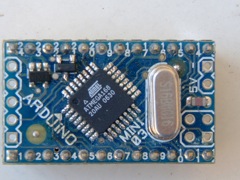
Arduino Mini 03
On this board, a solder point for digital pin 7 was
added to the edge of the board (next to the solder points for TX, RX, +5V, and Ground).
Each of the pins is numbered and the board is labelled "Mini 03".
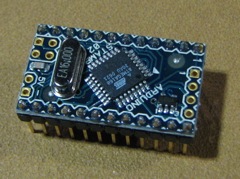
Arduino Stamp 02
The initial production version of the Arduino Mini
was labelled "Stamp 02".
Technically, this isn't an "Arduino board" since it doesn't have a microcontroller. Instead, it's an adapter that provides the Arduino Mini with a USB connection.
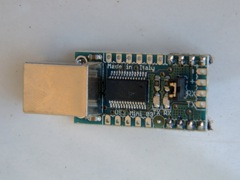
Mini USB Adapter 03
This version of the Mini USB Adapter breaks out
many more pins of the FTDI USB-to-serial chip. It is labeled "USB Mini 03".
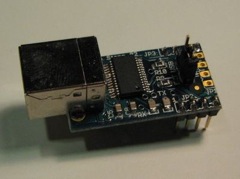
Mini USB Adapter
The original Mini USB Adapter was labelled "Arduino
Stamp 02".
The serial versions of the Arduino board are primarily sold unassembled as kits or just PCBs.
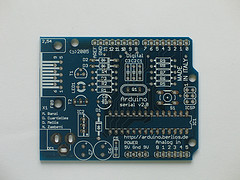
Arduino Serial v2.0
A revised version of the serial board with the
URL "arduino.berlios.de".
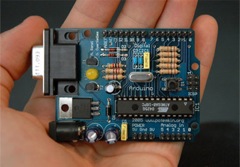
Arduino Serial
The original version of the Arduino serial board.
Includes the url "www.potemkin.org".
This version of the Arduino serial board has traces on only one side, making it easy to produce by hand. It was never manufactured, but rather published on the Arduino website for people to make themselves.
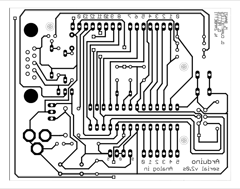
Copyright 2007 http://www.arduino.cc/